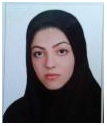زهرا فتحیان- Zahra Fathian-zfathian@yahoo.com
عنوان : ساخت و مشخصه¬يابي لحيم نانوكامپوزيتي بدون سرب (Sn-Cu-SiO2(np
TITLE : Synthesis and characterization of Tin-Copper / nano-silica Lead-free nanocomposite solder
آلياژ لحيم يوتكتيك قلع-مس نسبت به ساير لحيم هاي بدون سرب موجود، ارزان قيمت است اما خواص مكانيكي ضعيف كاربرد آن را محدود كرده است. در اين پژوهش در مرحله اول ساخت لحيم بدون سرب Sn-0.7wt%Cu به روش آلياژ سازي مكانيكي انجام شد. بررسي هاي ريز ساختاري و آزمونهاي طيف سنجي پراش انرژي پرتو ايكس، پراش پرتو ايكس و آناليز حرارتي بهمنظور ارزيابي ميزان پيشرفت آلياژ سازي مكانيكي انجام و بر اين اساس شرايط بهينه ساخت اين آلياژ تعيين گرديد. نتايج بهدست آمده نشان داد كه آلياژ سازي مكانيكي اين آلياژ در زمان 60 ساعت، سرعت 250 دور بر دقيقه، با نسبت گلوله به پودر 10 به يك و تحت اتمسفر محافظت شده آرگون به طور كامل انجام شد. نتايج نشان داد پس از آلياژ سازي مكانيكي با شرايط بيان شده مس در ساختار انحلال پيدا كرده و فاز Cu۶Sn۵ تعادلي تشكيل شده است. همچنين در تصاوير ميكروسكوپي نوري، مس در ساختار مشاهده نشد. در نمودار هاي آناليز حرارتي پيك تغيير آلوتروپي فاز Cu۶Sn۵ ديده و پيك انحلال مس حذف گرديد درحاليكه تغيير خط پايه مشاهده نشد. در مرحله دوم ساخت لحيم بدون سرب نانوكامپوزيتي -Cu-SiO2(np)به روش متالورژي پودر و با طي مراحل آسياكاري، فشردهسازي، تف جوشي و اكستروژن با موفقيت انجام شد. نانو ذرات SiO۲ كه خود به روش ارزان و آساني توليد ميشوند باعث بهبود خواص حجمي اين لحيم ميشوند به اين صورت كه افزايش ۵/۱ درصد نانو ذره موجب افزايش ۲۷ درصدي استحكام نهايي، افزايش ۲۳ درصدي استحكام تسليم و افزايش ۴۱ درصدي استحكام فشاري نسبت به نمونه شاهد خود شد. از طرفي با افزايش ذره تقويت كننده تا ۲ درصد زاويه تر كنندگي لحيم نيز ۵۰ درصد كاهش نشان داد. بررسي تصاوير ميكروسكوپي نيز نشان داد با افزايش نانو ذره بيش از نيم درصد، اين نانو ذرات در مرز پودر هاي اوليه كلوخه شده و نواحي مرز مانندي را ايجاد كرده و باعث افت خواص كامپوزيت در مقدار بيش از ۵/۱ درصد نانو ذره تقويت كننده شدند.
كلمات كليدي: آلياژ يوتكتيك قلع-مس، آلياژ سازي مكانيكي، لحيم بدون سرب، نانوكامپوزيت، خواص مكانيكي، زاويه ترشوندگي
Eutectic solder tin-copper alloy compared to other lead-free solder paste available, is inexpensive but poor mechanical properties has limited its use. In this tudy was carried out in the first construction of lead-free solder Sn-0.7wt% Cu by mechanical alloying. In order to evaluate the progress of mechanical alloying was carried out investigation of microstructure and Energy dispersive X-ray spectroscopy tests, X-ray diffraction and Thermal Analysis and accordingly determined the optimal conditions construction of the alloy. The results showed that the mechanical alloying was completed in 60 hours, at 250 rpm, the ball to powder ratio of 10 to one and is protected under an argon atmosphere. The results showed after mechanical alloying with the conditions stated the copper has dissolution in the structure and phase equilibrium Cu6Sn5 is formed. Also in light microscopic images, there was no copper in the structure. In Thermal Analysis graph change of allotropic phase Cu6Sn5 was seen and peak copper dissolution was removed while there was no change in base line. In the second phase construction of lead-free solder nanocomposite -Cu-SiO2 (np) successfully completed by powder metallurgy method and process of milling, pressing, sintering and extrusion. Nano-SiO2 which through cheap and easily way produced are improves the properties of the volume of the solder, this means an increase of 1.5 percent nanoparticles increase of 27% strength, 23 percent increase in yield strength and 41% increase compressive strength compared to the his control sample. Increasing particle amplifier to 2% solder wetting angle has been reduced by 50 percent. Also showed micrographs with increasing nanoparticle more than half a percent, the nanoparticles agglomerate in early powder border and creating a the border areas and were a drop in composite properties in the amount of more than 1.5 percent nanoparticles amplifier.
Keywords: tin-copper eutectic alloy, mechanical alloying, lead-free solder, nanocomposites, mechanical properties, wettability angle

